Podcast: Play in new window | Download
Subscribe: Apple Podcasts | RSS
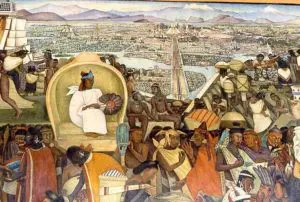 A few days after Cortés and his band of conquistadors entered the Aztec capital of Tenochtitlán as guests of Emperor Montezuma in 1519, a small group of Spaniards were escorted about half an hour north of the civic-ceremonial center of the city to an area known as Tlatelolco. Tlatelolco was once its own independent city-state before it was absorbed into the early Aztec Empire and later the capital city itself. The Aztec escort brought the Spaniards to Tlatelolco to visit the market there, the largest in the empire and perhaps the largest ever to have existed in the pre-Hispanic Americas. Later in his life, one of the Spanish marketplace visitors, a man named Bernal Díaz del Castillo, would write this in his memoirs about Tlatelolco:
A few days after Cortés and his band of conquistadors entered the Aztec capital of Tenochtitlán as guests of Emperor Montezuma in 1519, a small group of Spaniards were escorted about half an hour north of the civic-ceremonial center of the city to an area known as Tlatelolco. Tlatelolco was once its own independent city-state before it was absorbed into the early Aztec Empire and later the capital city itself. The Aztec escort brought the Spaniards to Tlatelolco to visit the market there, the largest in the empire and perhaps the largest ever to have existed in the pre-Hispanic Americas. Later in his life, one of the Spanish marketplace visitors, a man named Bernal Díaz del Castillo, would write this in his memoirs about Tlatelolco:
“We turned to look at the great marketplace and the crowds of people that were in it, some buying and others selling, so that the murmur and hum of their voices and words that they used could be heard more than a league off. Some of the soldiers among us who had been in many parts of the world, in Constantinople, and all over Italy, and in Rome, said that so large a marketplace and so full of people, and so well regulated and arranged; they had never seen before.”
The marketplace at Tlatelolco had items for sale from all parts of the empire and beyond. The Spanish marveled at the products offered, the organization of such a vast market and its cleanliness. On its busiest days there were over 50,000 people there, buying and selling.
One of the core activities in any empire is trade. The Aztec Empire at the time of the Spanish Conquest had a vast and complicated trade network that had an equally complex infrastructure and bureaucracy to support it. The pochteca, the elite class of long-distance traders, played an essential role in Aztec commerce and Aztec statecraft.
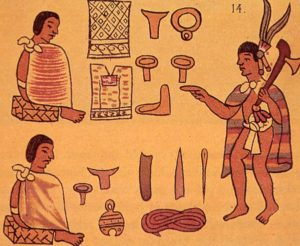 Trade networks existed in ancient Mexico long before the Aztecs occupied the central valleys that would later become the core of their empire. Archaeologists have seen long-distance trade in the archaeological record as far back as what is termed as the Early Formative period with the ascendancy of the Olmecs a few thousand years ago. The great city of Teotihuacán, which reached its height in central Mexico at around 400 AD, had trade networks reaching as far away as modern-day Guatemala and the American Southwest. Other Mesoamerican groups engaged in foreign trade, but researchers know the most about the Aztecs because they were a living, breathing civilization at the time of the Spanish contact. Early Spanish chroniclers wrote down the specifics of the everyday lives of the Aztecs in great detail and from these accounts we know a great deal about the long-distance trading class of people called the pochteca.
Trade networks existed in ancient Mexico long before the Aztecs occupied the central valleys that would later become the core of their empire. Archaeologists have seen long-distance trade in the archaeological record as far back as what is termed as the Early Formative period with the ascendancy of the Olmecs a few thousand years ago. The great city of Teotihuacán, which reached its height in central Mexico at around 400 AD, had trade networks reaching as far away as modern-day Guatemala and the American Southwest. Other Mesoamerican groups engaged in foreign trade, but researchers know the most about the Aztecs because they were a living, breathing civilization at the time of the Spanish contact. Early Spanish chroniclers wrote down the specifics of the everyday lives of the Aztecs in great detail and from these accounts we know a great deal about the long-distance trading class of people called the pochteca.
There were many people throughout the Aztec Empire and in ancient Mexico as a whole engaging in petty commerce much as experienced in Mexico today. Every town had its market where common citizens would offer some of their crops, their fish catches or some of their handywares, and shoppers would barter and haggle much as they still do today. The small-time vendors at many of these markets were not considered to be a part of a distinct class, though, and many of them engaged in commerce part-time to get rid of their surplus. The larger cities had bigger and more sophisticated markets, with the ultimate marketplace located at Tlatelolco, as already mentioned. In the larger markets shoppers would delight in finding luxury goods from all parts of the empire and beyond, courtesy of the pochteca, the specific group of traders who held a monopoly on foreign commerce. The members of the pochteca class traded the products of central Mexico across long distance in exchange for the exotic. To faraway lands they would bring cloth, embroidered clothes, rabbit’s-hair blankets, obsidian knives, fine jewelry made of copper or gold, medicinal herbs and cochineal dye. They would bring back to central Mexico rare 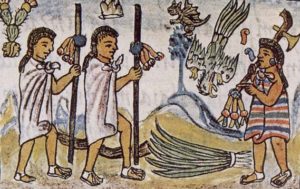 and expensive items such as sea shells, emeralds, tropical bird feathers, translucent jade, jaguar pelts, tortoiseshell, amber and cacao. The pochteca usually traded finished goods for exotic raw materials. Because of the Aztec tribute system, many raw materials flowed into the Valley of Mexico from subjugated peoples throughout the empire in the form of taxes. According to the Codex Mendoza, for example, the provinces of Quauhtochco and Ahuilizapan were to send 1,600 bales of cotton to the Aztec capital each year. In the capital the cotton was finished into marketable goods. The pochteca then took the finished goods on their long-distance journeys. There were no beasts of burden in ancient Mexico and no use of the wheel, so there were no pack animals and no carts. All merchandise was carried on the backs of porters. Because merchandise was not able to be moved in a massive scale or quickly, as we are used to today, food was rarely traded over the long distances.
and expensive items such as sea shells, emeralds, tropical bird feathers, translucent jade, jaguar pelts, tortoiseshell, amber and cacao. The pochteca usually traded finished goods for exotic raw materials. Because of the Aztec tribute system, many raw materials flowed into the Valley of Mexico from subjugated peoples throughout the empire in the form of taxes. According to the Codex Mendoza, for example, the provinces of Quauhtochco and Ahuilizapan were to send 1,600 bales of cotton to the Aztec capital each year. In the capital the cotton was finished into marketable goods. The pochteca then took the finished goods on their long-distance journeys. There were no beasts of burden in ancient Mexico and no use of the wheel, so there were no pack animals and no carts. All merchandise was carried on the backs of porters. Because merchandise was not able to be moved in a massive scale or quickly, as we are used to today, food was rarely traded over the long distances.
While almost anyone could sell in the common markets, the pochteca had a monopoly on long-distance trade. They were organized into corporations or guilds and the pochteca had a great deal of autonomy in Aztec society. They lived in their own designated districts in the major cities of the Aztec Empire such as Chalco, Texcoco, Otumba and others, and of course, in the capital city of Tenochtitlán. Before Tlatelolco was absorbed into the capital city, the pochteca had great prominence there and lived in a district of the city called Pochtlan, and hence the name of the class of traders. In the pochteca districts of the major Aztec cities the traders enjoyed privileges unique to them. Each pochteca group was ruled by elders who were experienced but no longer able to travel the long distances. The elders would represent the pochteca before the emperor and would conduct their own ceremonies and would administer their own form of justice among this elite merchant class. In ancient Aztec society the emperor’s courts judged everybody from the priestly class to the members of the nobility to the commoners. Only the pochteca had separate justice outside direct imperial authority. The pochteca married among themselves and the profession could only be passed down from father to son. Male children of the pochteca attended elite schools alongside the children of priests and minor nobles. The pochteca had their own religious observances and prayed to their own gods without the assistance of the Aztec priests. On long journeys they were their own priests and were also their own fighting force. Many pochteca were considered great warriors as they had to fend off attacks from marauders on the road who coveted their wares. They were also exempt from manual labor and personal service. In effect, the pochteca were a nation within a nation. The ruling class permitted this because of the valuable roles they played throughout the empire and beyond.
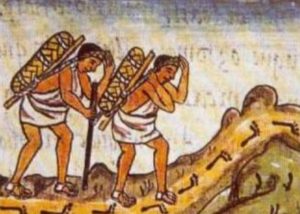 One of the first examples that the pochteca were more than just long-distance traders happened during the reign of Emperor Auitzotl around the year 1490. A column of pochteca was surrounded by hostile forces near the town of Anahuac Ayotlan, hundreds of miles from the Aztec capital of Tenochtitlán on the Pacific side of the Isthmus of Tehuantepec. The pochteca were besieged by warriors from several tribes and held out against them for 4 years. An Aztec military rescue party led by future Emperor Montezuma was sent to rescue the traders but only met up with them on the road during their return to the capital city, laden with all the goods from the warring tribes they did battle with. This valiant group was presented before Emperor Auitzotl who showered them with accolades and allowed them to wear special insignia, thus elevating their status in Aztec society. The speech that the head pochteca made to the emperor survives to this day, transcribed from an oral account by early Spanish chronicler Bernardino de Sahagún:
One of the first examples that the pochteca were more than just long-distance traders happened during the reign of Emperor Auitzotl around the year 1490. A column of pochteca was surrounded by hostile forces near the town of Anahuac Ayotlan, hundreds of miles from the Aztec capital of Tenochtitlán on the Pacific side of the Isthmus of Tehuantepec. The pochteca were besieged by warriors from several tribes and held out against them for 4 years. An Aztec military rescue party led by future Emperor Montezuma was sent to rescue the traders but only met up with them on the road during their return to the capital city, laden with all the goods from the warring tribes they did battle with. This valiant group was presented before Emperor Auitzotl who showered them with accolades and allowed them to wear special insignia, thus elevating their status in Aztec society. The speech that the head pochteca made to the emperor survives to this day, transcribed from an oral account by early Spanish chronicler Bernardino de Sahagún:
“We, your uncles, the pochteca who are here, we have risked our head and our lives, and we have labored day and night; for although we are called traders and although we seem to be traders, we are captains and soldiers who, in a disguised fashion, go out to conquer.”
It was then when the Aztec ruling class realized that the pochteca were not only traders but could be used to gather intelligence and even to be used as a proxy military in the faraway lands of yet unsubjugated peoples. While the emperor and his ministers found the pochteca useful in this regard, the traders had to make sure they did not overcome their class and position in society so as not to anger members of the Aztec elites. While many pochteca became wealthy and influential because of their exploits, they knew that they had to play down their status and wealth and not overstep the rigid boundaries of class. A pochteca could be richer than members of the emperor’s extended family, for example, but they did not dare flaunt it in public. Many members of the pochteca class dressed in ordinary clothes and had the demeanor of commoners so as not to attract the attention and possible ire of those of “good birth.” Sahagún wrote about the need for the pochteca to be modest. From his chronicles:
“The traders did not parade their wealth, but on the contrary, they were lowly and humble. They did not wish to be thought rich, nor to have the reputation of wealth; they desired neither honors nor fame, and they walked humbly, without raising their eyes. They went in worn-out cloaks and they feared honor and renown above all.”
Basically, the pochteca were allowed to continue enjoying their special status just as long as they kept up with their difficult work of brining luxury goods to the elites and as long as they didn’t flaunt their wealth.
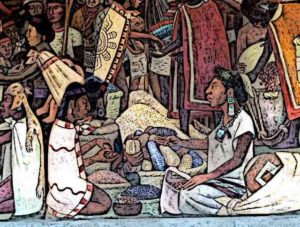 There were several different types of pochteca in the Aztec Empire. The Pochteca Teucnehnenqueh or “traveling lords,” traded on behalf of the nobility – personal shoppers, so to speak – and were considered the highest rank of pochteca. There was also the Naualoztomeca or the “disguised traders” who would learn the languages and customs of the destination country and funnel back intelligence to Tenochtitlán. The Tealtianime were slave merchants who brought back captives to the Aztec heartland for human sacrifice. The Iyahqueh acted as the support along the trade routes, manning depots and waystations and were important links in the trade networks in faraway places.
There were several different types of pochteca in the Aztec Empire. The Pochteca Teucnehnenqueh or “traveling lords,” traded on behalf of the nobility – personal shoppers, so to speak – and were considered the highest rank of pochteca. There was also the Naualoztomeca or the “disguised traders” who would learn the languages and customs of the destination country and funnel back intelligence to Tenochtitlán. The Tealtianime were slave merchants who brought back captives to the Aztec heartland for human sacrifice. The Iyahqueh acted as the support along the trade routes, manning depots and waystations and were important links in the trade networks in faraway places.
It appears that over time the power and influence of the mercantile class grew. At the time of the Spanish Conquest the pochteca were so influential that they were even marrying off their daughters into the nobility. It was noted that Nezaualpilli, one of the last rulers of the Kingdom of Texcoco married a “merchant’s daughter” from the city of Tula. This woman known as “the Lady of Tula” was described this way in the Historia Chichimeca, a minor chronicle of colonial New Spain:
“She was so cultured that she could give points to the king and the most cultivated men, and she was poetically gifted. And with these gifts and graces she held the king very much under her domination… She lived apart, in great pomp and majesty, in a palace that the king had built for her.”
Had the Spanish Conquest not occurred it would have been interesting to see what would have happened to this wealthy and cultured merchant class. Would they have eventually been co-opted and absorbed into the Aztec nobility? Would their ranks and wealth have grown to overshadow and replace the hereditary system of nobles governing the empire? Their upward trajectory was clear but ultimately cut short.
REFERENCES
Drennan, Robert D. “Long-Distance Movement of Goods in the Mesoamerican Formative and Classic.” In American Antiquity, vol. 49, no. 1, Jan.1994, pp. 27-43.
Soustelle, Jacques. Daily Life of the Aztecs on the Eve of the Spanish Conquest. Stanford: Stanford University Press, 1961.
